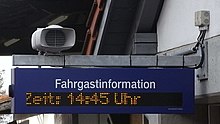Dynamic font indicator
A dynamic text display ( DSA ) is a passenger information system that Deutsche Bahn mainly uses at smaller train stations and stops. The devices show a single-line ticker on an LED display and are usually also equipped with loudspeakers ("acoustic module"). They are connected to the DSA center via GSM , which receives the traveler information from the central traveler information system IRIS.
The resolution of the LED display is 96 × 8 points. The main purpose of the display is to display "deviation information" (deviations from the daily schedule) in order to inform passengers in the event of disruptions in rail operations. Since March 10, 2011, the current time has also been displayed if there are no faults. The display of the current time, provided there is no fault message, is now in idle text so that it is easier to see from a further distance whether or not there is a disruption to rail operations. In even months (February, April, June ...) the time is right-justified, in odd months (January, March, May ...) it is left-justified.
DSA are mainly used at stations in the lower categories (5–7). The use of DSA is also planned at smaller stations in the higher categories. Currently (as of September 2018) almost 6650 DSA are installed. In order to monitor their functionality, DB Station & Service operates a central control center in Berlin Central Station . Around 4,500 of the installed DSAs were financed from the federal economic stimulus programs. After the economic stimulus program was over, the DB subsidiary Station & Service was instructed by the Federal Railway Authority to equip all stations with passenger information systems or loudspeakers. In several court cases, the company had tried to obtain exemptions for low-traffic stops without adequate energy and mobile phone coverage, but failed in every instance. The Federal Administrative Court ordered Deutsche Bahn to equip all stops with passenger information systems by 2019.
The devices are operated fully automatically. Acoustic announcements come from a speech generator.
The DSA is produced in two versions with one or two-sided display. For the sake of better visibility, it is usually mounted across the direction of the platform; Usually two one-sided DSAs are used on masts, which can be read from opposite directions. When mounting on a building wall, the two-sided version is often used, which then hangs on a cantilever beam. This construction is also possible on sufficiently stable masts.

The Westfrankenbahn developed a three-line version for its stations, which also shows the next train departures. Similar devices have also been in use at the Erzgebirgsbahn , also an organizational unit of DB RegioNetz Infrastruktur GmbH , since the end of 2017 .
On September 23, 2017, Deutsche Bahn presented the next generation of dynamic text displays. These devices should have several display lines and, for example, also display destinations and following trains.
In the Rhein-Main-Verkehrsverbund , the DSA received a gradual software adjustment from September 2018 and since then has not only displayed irregularities, but also the next scheduled train. This software adaptation is now available in all federal states.
Web links
Individual evidence
- ↑ a b c Peter Kradepohl: New DSA modules. (No longer available online.) In: Mobility Conference NRW. May 20, 2011, formerly in the original ; Retrieved June 30, 2012 . ( Page no longer available , search in web archives )
- ↑ Quick help with traveler information . In: DB World . No. 9 , 2015, p. 6 .
- ↑ Construction programs at train stations - federal programs - economic stimulus program. (No longer available online.) Deutsche Bahn AG, archived from the original on September 25, 2015 ; accessed on September 24, 2015 .
- ↑ Deutsche Bahn has to inform about delays at stops. In: Zeit Online , September 9, 2015.
- ↑ a b DB Netze: Information dynamic font display. (No longer available online.) In: feldkirchen-westerham.de. April 18, 2011, formerly in the original ; Retrieved June 30, 2012 . ( Page no longer available , search in web archives )
- ↑ Mast with DSA boom (YouTube)
- ↑ Passenger information is very important at small stations. In: customer magazine WFB-Takt 01/2016. Retrieved March 14, 2017 .
- ↑ Next generation of dynamic text display (DSA). In: DB look into the workshop. Retrieved June 11, 2018 .
- ↑ Better passenger information at smaller train stations. Deutsche Bahn, September 24, 2018, accessed on November 9, 2018 .
- ↑ Oliver Schumacher: Topic Service: Well informed even at small train stations. In: Deutsche Bahn AG. April 2019, accessed November 9, 2019 .


